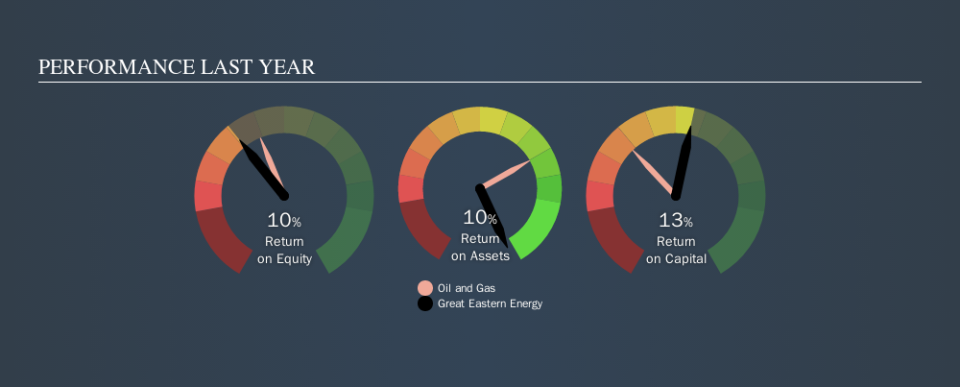A Close Look At Great Eastern Energy Corporation Limited’s (LON:GEEC) 13% ROCE

Today we'll evaluate Great Eastern Energy Corporation Limited (LON:GEEC) to determine whether it could have potential as an investment idea. Specifically, we'll consider its Return On Capital Employed (ROCE), since that will give us an insight into how efficiently the business can generate profits from the capital it requires.
First up, we'll look at what ROCE is and how we calculate it. Next, we'll compare it to others in its industry. Then we'll determine how its current liabilities are affecting its ROCE.
Return On Capital Employed (ROCE): What is it?
ROCE measures the amount of pre-tax profits a company can generate from the capital employed in its business. All else being equal, a better business will have a higher ROCE. In brief, it is a useful tool, but it is not without drawbacks. Author Edwin Whiting says to be careful when comparing the ROCE of different businesses, since 'No two businesses are exactly alike.
How Do You Calculate Return On Capital Employed?
Analysts use this formula to calculate return on capital employed:
Return on Capital Employed = Earnings Before Interest and Tax (EBIT) ÷ (Total Assets - Current Liabilities)
Or for Great Eastern Energy:
0.13 = US$22m ÷ (US$174m - US$14m) (Based on the trailing twelve months to March 2019.)
Therefore, Great Eastern Energy has an ROCE of 13%.
Check out our latest analysis for Great Eastern Energy
Is Great Eastern Energy's ROCE Good?
ROCE can be useful when making comparisons, such as between similar companies. Great Eastern Energy's ROCE appears to be substantially greater than the 8.7% average in the Oil and Gas industry. We would consider this a positive, as it suggests it is using capital more effectively than other similar companies. Independently of how Great Eastern Energy compares to its industry, its ROCE in absolute terms appears decent, and the company may be worthy of closer investigation.
We can see that, Great Eastern Energy currently has an ROCE of 13% compared to its ROCE 3 years ago, which was 6.8%. This makes us wonder if the company is improving. You can see in the image below how Great Eastern Energy's ROCE compares to its industry. Click to see more on past growth.
Remember that this metric is backwards looking - it shows what has happened in the past, and does not accurately predict the future. Companies in cyclical industries can be difficult to understand using ROCE, as returns typically look high during boom times, and low during busts. This is because ROCE only looks at one year, instead of considering returns across a whole cycle. Remember that most companies like Great Eastern Energy are cyclical businesses. What happens in the future is pretty important for investors, so we have prepared a free report on analyst forecasts for Great Eastern Energy.
Great Eastern Energy's Current Liabilities And Their Impact On Its ROCE
Short term (or current) liabilities, are things like supplier invoices, overdrafts, or tax bills that need to be paid within 12 months. The ROCE equation subtracts current liabilities from capital employed, so a company with a lot of current liabilities appears to have less capital employed, and a higher ROCE than otherwise. To counter this, investors can check if a company has high current liabilities relative to total assets.
Great Eastern Energy has total assets of US$174m and current liabilities of US$14m. Therefore its current liabilities are equivalent to approximately 7.9% of its total assets. In addition to low current liabilities (making a negligible impact on ROCE), Great Eastern Energy earns a sound return on capital employed.
What We Can Learn From Great Eastern Energy's ROCE
This is good to see, and while better prospects may exist, Great Eastern Energy seems worth researching further. There might be better investments than Great Eastern Energy out there, but you will have to work hard to find them . These promising businesses with rapidly growing earnings might be right up your alley.
For those who like to find winning investments this free list of growing companies with recent insider purchasing, could be just the ticket.
We aim to bring you long-term focused research analysis driven by fundamental data. Note that our analysis may not factor in the latest price-sensitive company announcements or qualitative material.
If you spot an error that warrants correction, please contact the editor at editorial-team@simplywallst.com. This article by Simply Wall St is general in nature. It does not constitute a recommendation to buy or sell any stock, and does not take account of your objectives, or your financial situation. Simply Wall St has no position in the stocks mentioned. Thank you for reading.


